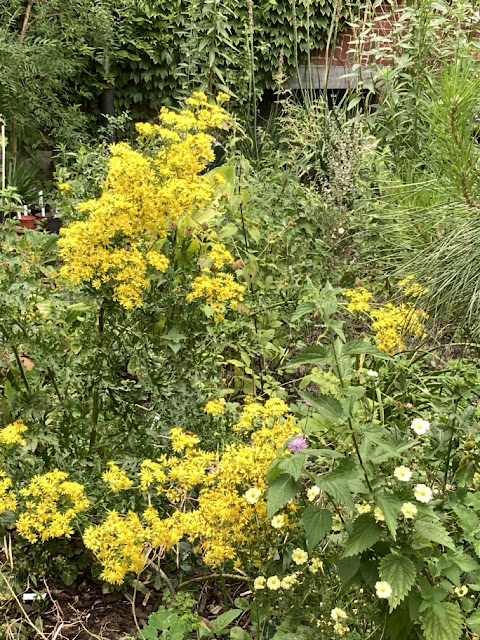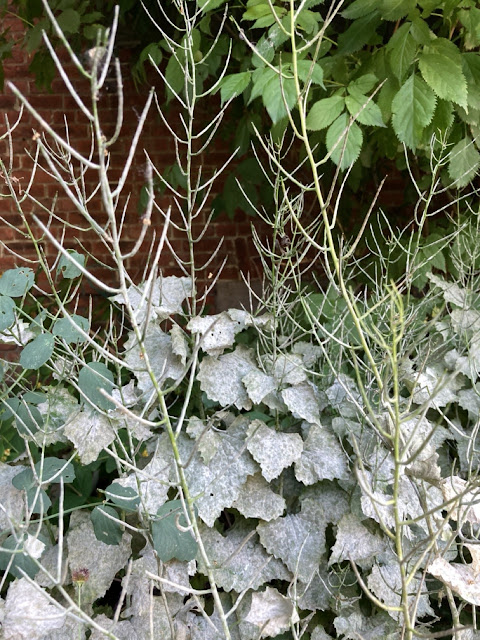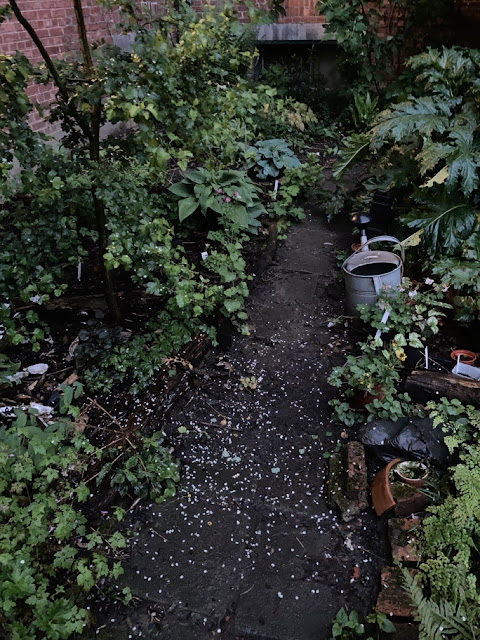In the summer of 2025 I was invited to a private artist studio in Koumi, Japan. During my stay I collaborated with Yoko Enoki on a big new painting, titled Got lost. The photo doesn't do justice to the size, the 5 meter wide canvas is made in a such way as to feel a little bit lost too, in a good way. For this art project we received the support from Claessens Japan, the company distributing the Flemish linen prepared for oil paint. Thank you so much, we are very grateful for your support!
This map on how to get lost in nature and many of the paintings we made during this summer will shown in Koumi Machi Kougen Museum in our exhibition opening in November 2025.
Here are a few of the paintings we made during our stay:
Got lost.
We got lost. No wifi, no data, only a very simple hand drawn map of the way to the lake. The clouds drift low, thunder rolls over the mountains in Koumi, Japan. Yoko Enoki joined me in these Yatsugatake foothills for an art collaboration. We're painting a map, not with impressions, but from experience. We walk in nature. The map is wrong, technically, because we never got to our destination at the lake.
We got lost, and walked very far, through farmlands under a blue sky, in the woods on soft brown dried pine needles, we stop for beetles and listen to birds. We missed a turn, or not. Somehow we arrived at the bathhouse just before the clouds broke and the rain obliterated the view. I'm not allowed to enter the bathhouse (tattoos) but the little roof at the entrance was enough cover. This is what I mapped out in the painting. The lake is left as a marker only, becuase we didn't see it.
In nature I'm scared of everything that bites, stings, sucks blood, claws, barks and so on. I do feel appreciation for others. Nature isn't a backdrop. As a queer painter 'agency' is a meaningful concept. In my personal life 'my nature' is an important touchstone for what is sensible.
My paintings are about what happens in the middle, the weather between us. That's what the map is about. Halfway we meet, between the tree and the window, between the landscape and the house, between us.

I wanted to paint about the preservation of nature, to urge people to act now. But what can I say when we already know what we need to know? How can I contribute to nature, especially when I am only a visitor in this country and culture? And yet, the sky is one big sky all around the world. It has no borders. I want to paint the view in the mountains, but I can’t, they are too big, too beautiful. I think of climate change, the genocide in Palestine, the Russian invasion in Ukraine, the rising hate towards refugees, the asocial attitudes against queer people, especially trans people. There is so much trouble going on. These problems are man made and affect a multispecies planet. If I were to ask nature, the trees, the water, the bear, the lilies, and others: what would you like to say to human beings? The answer might be: get lost. Some of us would only be lost for a moment, and find our way back by following the sound of water. But not all is lost and we can still do something, because we're in this together and everything matters.

Koumi, 25 July 2025
This is the text written by Yoko Enoki:
Koumi-note
This was my second time participating with Eline De Clercq on a collaborative work.
For the first one, made at ARCUS in Ibaraki Prefecture, I heard from Eline that she would make a map, and I came prepared with ideas about boundaries and land ownership. However, as I began walking around the town listening to Eline, who teaches gardening at an academy and has a deep knowledge of plants, the Ibaraki Prefecture I knew quickly disappeared. It was when we came across a field of leeks. "Leeks are an ancient vegetable that turned blue to protect itself from the sun," Eline said. "Leeks are blue." It was a sudden paradigm shift. Leeks, which I had always thought of as green, were indeed blue. Since then, I've started calling my walks with Eline botanical walks, and every time I walk with her, something invisible to my eyes appears.
We came to Koumi, a place with beautiful mountains and lakes, cool summers, and few natural disasters. I also heard that the highland vegetables and fruits are fresh and delicious, and there are even hot springs. And it was true. On the second day, I started walking around town and sketching. I couldn't stop tracing the endless layered mountain ridges.

Then, I went on a botanical walk with Eline. First, we visited the garbage collection site. As we walked and talked about how to dispose of food waste, Eline pointed to the edge of the vegetable patch. "This is a wild orchid, and it's rare. The flowers bloom in a spiral," she said, and there, at the tip of her finger, was a tiny flower that looked nothing more than a weed, indeed blooming in a spiral. On another day, Eline noticed a plant in the garden of the house next door where we were staying. It looked very similar to a lily, but it was green and the flowers bloomed at right angles and parallel to the ground. While I was taking photos, Mrs. Kurosawa passed by in a pickup truck and told me that in this area they are called babayuri (official name: Ubayuri, but don't you think that's a bit of a harsh term?), and that they are a type of wildflower that doesn't take root well in other places. This, too, was invisible to my eyes, and I thought it was ugly when I first perceived it. I had only ever recognized flowers as flowers if I saw them in the supermarket. What a foolish sensibility! I decided to paint the orchids and lilies that I hadn't seen; they are large and difficult to see, so that viewers would have the same experience.
While strolling through the impeccably beautiful town, gazing at the mountains, and painting, devastating images of the wars in Gaza and Ukraine, and the destruction of my hometown (Wajima City, Ishikawa Prefecture), came to mind. It seems Eline felt the same way, and when she suggested include a message in our paintings, I agreed without hesitation. For us living today, the meaning of pure art is gradually being lost. I create my work while drawing on new insights, global issues, family issues, conversations with people, and relationships with viewers. I sense a provocative, human vibe from Antwerp in Eline's work and her creative approach, which values process. To deepen my understanding, I pulled out books like "Relational Aesthetics" and skimmed through them. It seems I'm not wrong after all.
.JPG)
Now, since last year, I've been painting landscapes of Wajima City, where my parents live. The town, which was physically destroyed by fire immediately after the earthquake and then flooded, is now being reborn in a completely new form. What I can do now is to depict the drastic changes occurring in a rural town that I thought would never change. I hope that by juxtaposing landscape paintings with vastly different meanings, the relationship between Eline's work and the viewer will become more interesting.
Anyway, Eline and I were in Koumi this summer, and we created this work with the desire to form a close connection with this place. Like us running desperately through the torrential rain in the evenings at Koumi, this work may seem a little comical to an outsider, but it is incredibly serious. Perhaps, it's a testament to my focused work, but even now, even after my stay here, I can still hear the distant thunder of Koumi as evening approaches.
August 9, 2025 Yoko Enoki
In 2025 a collaborative artwork, a map on linen canvas, was made together. Eline and Yoko know each other for more than 20 years, and their friendship inspires an artistic exchange. The middle of the map is dedicated to Palestine, because we can't go on as we used to while a genocide takes place. We also believe that it is time to look at other places in the world where extraction of natural richness leads to hunger, war and suffering.
The paintings made by Eline in Koumi:
Got Lost, 217 x 500cm (including linen edge), oil on canvas, collaborative painting by Eline De Clercq and Yoko Enoki.
Queer weather today, 70 x 406 cm, oil on canvas
Small paintings A4, oil on canvas mounted on veneer
Small paintings 23 x 31 cm, oil on cotton paper
Queer weather today is a painting about the weather and it is about queer visibility and climate change. The image is inspired by the mountain weather, changing so fast during the day. It is strange weather, queer. But being a lesbian, 'queer' is also meant as a reference to the LGBTQI+ community. Being queer is as natural as the weather, and this painting is in recognition of our community. There is also a looming danger in this painting, the moment is passing and we see the weather turning more and more extreme, as a result of climate change. Queer people also live in a more extreme climate, where hate speech is getting more severe by the day. There will come a time when the next generation will look at us and ask: you knew, what did you do?
This painting is not part of the exhibition in Koumi museum.
Details:
The small paintings ( canvas A4 + paper 23 x 31 cm) are connected to these other two paintings and are made to let my mind go wandering. They are playful in use of colour, composition, contrast, brush strokes. Much like a musical etude, they are about building up concentration and awareness. A selection:














.JPG)








































